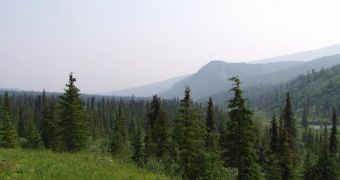Today's Greenland is an icy polar desert; just on the southern coast, there is some tundra vegetation, with its giants represented by dwarf birch and willows that do not grow taller than 1-2 ft (0.3-0.6 m). The name "Greenland" was given by the first Viking explorers just to attract colonists to the area. Wood drifted by sea from Labrador peninsula also made them believe there were forests nearby. But now ancient DNA recovered from under more than a mile (1.6 km) of Greenland ice points that the island did have large forests in a much warmer clime during the last Ice Age.
It resulted that between 450,000 and 800,000 years ago, most of Greenland was covered in a boreal forest (taiga), just like seen today in most of central Canada and Siberia, made of mighty spruce, pine and alder trees and harboring insects like butterflies and beetles. Based on this ecosystem, the researchers suppose that Greenland's weather once varied from 50 ?F (10 ?C) in summer to 1.4 ?F (-17 ?C) in winter, the temperature range in which these tree species thrive.
"We have shown for the first time that southern Greenland...was once very different to the Greenland we see today," said lead researcher Eske Willerslev of the University of Copenhagen.
"Less glacial cover in ancient Greenland means the global ocean was probably between three and six feet (1-2 m) higher during that time compared to current levels", said the researchers.
"To get this site ice free you would've had to remove the ice cover from about the southern third of Greenland," co-author Martin Sharp, a glaciologist at the University of Alberta, Canada, told LiveScience.
The ancient DNA analysis technique now allows the researchers to recreate an environment's climate and ecology without the need for fossils, which can miss or be hard to dig out.
"To go from dirty water to a forest full of insects is pretty amazing," Matthew Collins, a biomolecular archaeologist at the University of York, not involved in this research.
The thick ice sheets of Greenland worked as a perfect, natural freezer for preserving the ancient DNA, in a much better condition than found on other places.
Other icy places, like Antarctica, could be investigated for fossil DNA.
"Given that 10 % of the Earth's terrestrial surface is covered by thick ice sheets, it could open up a world of new discoveries," said co-author Enrico Cappellini of the University of York in the United Kingdom.

 14 DAY TRIAL //
14 DAY TRIAL //